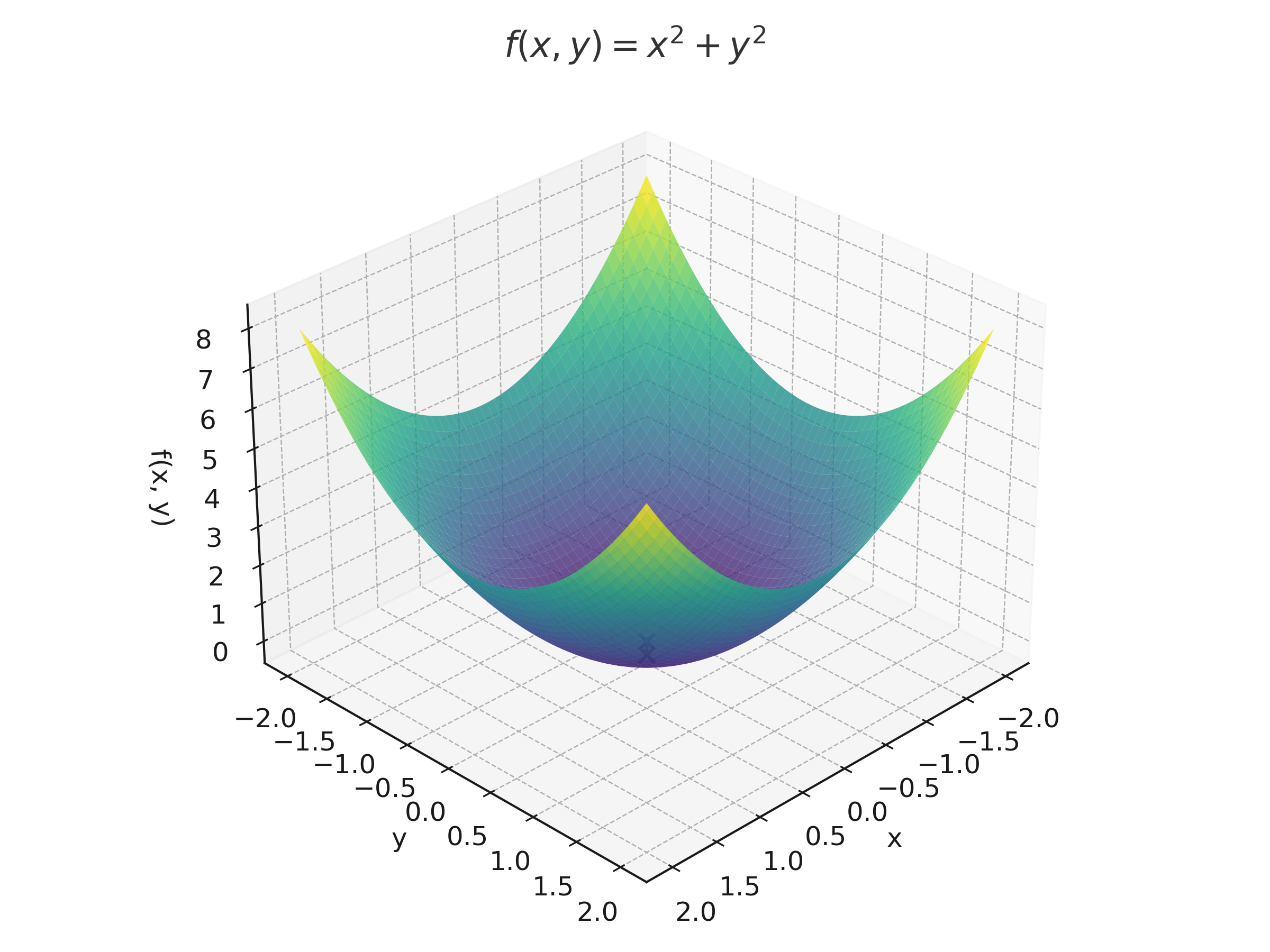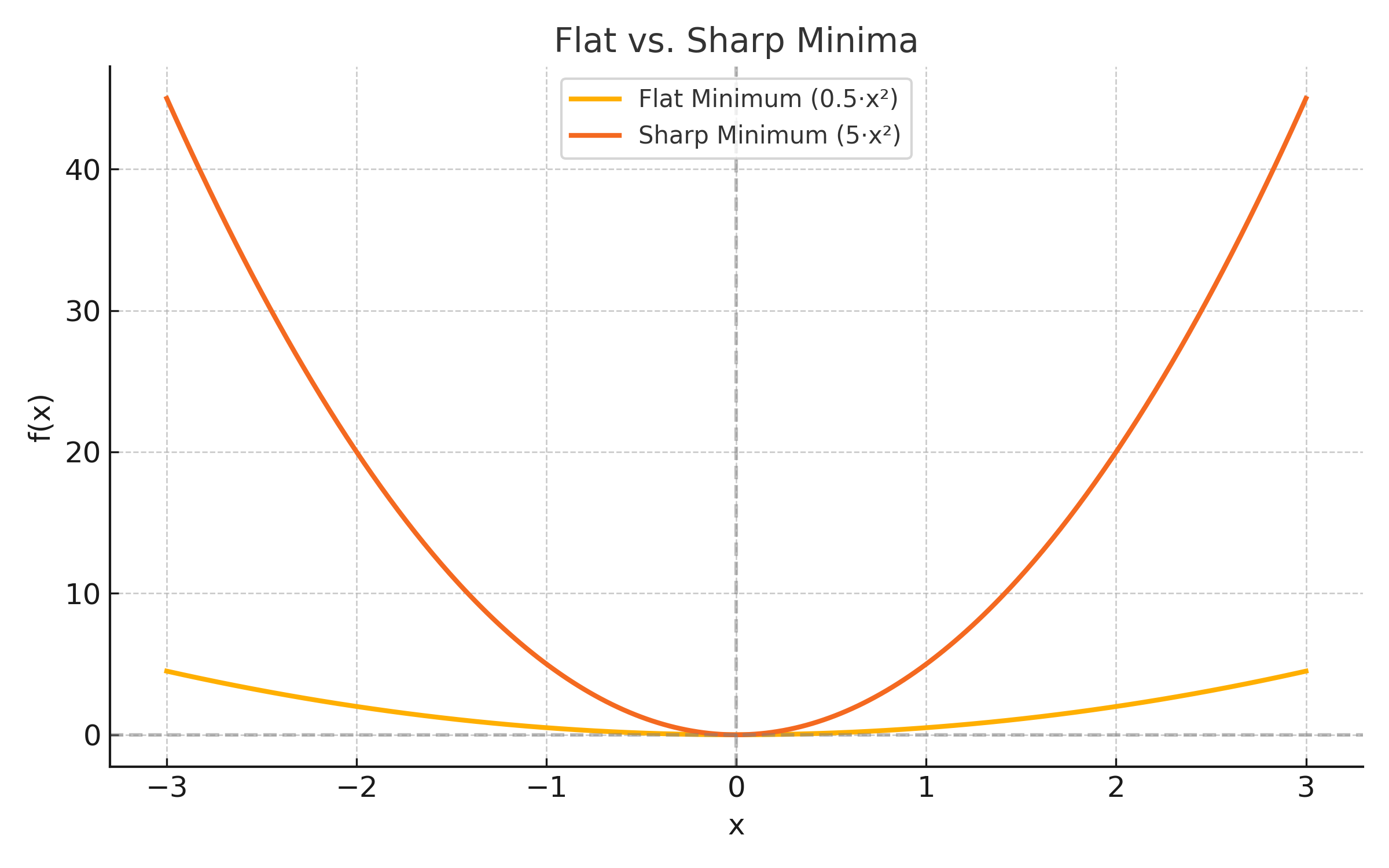🔺 What is the Hessian? Understanding Curvature and Optimization in Machine Learning
Learn how the Hessian matrix extends partial derivatives to second-order curvature, and why it's essential for optimization, convexity, and machine learning algorithms like Newton’s Method.
🔺 What is the Hessian?
In multivariable calculus, the gradient gives us direction — but what about shape?
That’s where the Hessian comes in. It tells us whether we’re in a valley, a ridge, or at a saddle point — and this insight powers many optimization algorithms used in machine learning.
📚 This post is part of the "Intro to Calculus" series
🔙 Previously: Understanding the Jacobian – A Beginner’s Guide with 2D & 3D Examples
🔜 Next: Optimization in Machine Learning: From Gradient Descent to Newton’s Method
🧮 Definition
The Hessian is the square matrix of second-order partial derivatives of a scalar function:
\[ H(f) = \begin{bmatrix} \frac{\partial^2 f}{\partial x^2} & \frac{\partial^2 f}{\partial x \partial y}
\frac{\partial^2 f}{\partial y \partial x} & \frac{\partial^2 f}{\partial y^2} \end{bmatrix} \]
- It captures how the gradient changes.
- If all second partials are continuous, the Hessian is symmetric.
- This symmetry comes from Clairaut’s theorem:
If the second partial derivatives are continuous, then
\( \frac{\partial^2 f}{\partial x \partial y} = \frac{\partial^2 f}{\partial y \partial x} \).
📐 Example: \( f(x, y) = x^2 + y^2 \)
Let’s compute the Hessian:
\[ \frac{\partial^2 f}{\partial x^2} = 2, \quad \frac{\partial^2 f}{\partial y^2} = 2, \quad \frac{\partial^2 f}{\partial x \partial y} = 0 \]
\[ H(f) = \begin{bmatrix} 2 & 0
0 & 2 \end{bmatrix} \]
The matrix is positive definite, so this function is convex everywhere.
🔍 Another Example: \( f(x, y) = x^2 - y^2 \)
\[ \frac{\partial^2 f}{\partial x^2} = 2, \quad \frac{\partial^2 f}{\partial y^2} = -2, \quad \frac{\partial^2 f}{\partial x \partial y} = 0 \]
\[ H(f) = \begin{bmatrix} 2 & 0
0 & -2 \end{bmatrix} \]
The eigenvalues have mixed signs, so this is a saddle point.
🧠 Geometric Meaning
- Hessian → curvature matrix
- If all eigenvalues > 0: bowl (local minimum)
- If all eigenvalues < 0: upside-down bowl (local maximum)
- Mixed signs: saddle point
A good function to visualize: \[ f(x, y) = x^2 + y^2 \quad \text{(bowl)}
f(x, y) = x^2 - y^2 \quad \text{(saddle)} \]
🧪 Python: Symbolic Hessian with SymPy
1
2
3
4
5
6
7
import sympy as sp
x, y = sp.symbols('x y')
f = x**2 + y**2
H = sp.hessian(f, (x, y))
H
Output:
1
2
3
4
Matrix([
[2, 0],
[0, 2]
])
Now try:
1
2
f2 = x**2 - y**2
sp.hessian(f2, (x, y))
🖼️ Visualizing Curvature
Use matplotlib or plotly to show:
- \( f(x, y) = x^2 + y^2 \): convex bowl
- \( f(x, y) = x^2 - y^2 \): saddle
We can also plot contour + gradient + Hessian vector field (advanced, optional).
⚙️ Newton’s Method and Optimization
In optimization, we often want to find the minimum of a function — where the gradient is zero and the curvature is positive.
🔁 First-order update (Gradient Descent)
Gradient descent uses only first derivatives:
\[ \theta_{\text{next}} = \theta - \eta \cdot \nabla f(\theta) \]
- Moves in the direction of steepest descent.
- Works well, but can be slow if the landscape is curved or poorly scaled.
🧠 Second-order update (Newton’s Method)
Newton’s method adds curvature awareness using the Hessian:
\[ \theta_{\text{next}} = \theta - H^{-1} \nabla f(\theta) \]
- Uses the inverse of the Hessian matrix to rescale the gradient.
- Adapts step sizes based on how “steep” or “flat” the surface is in different directions.
- Can converge faster than gradient descent near minima.
📌 Example: Newton Step in 2D
Suppose:
\[ f(x, y) = x^2 + y^2 \Rightarrow \nabla f = \begin{bmatrix} 2x \\ 2y \end{bmatrix}, \quad H(f) = \begin{bmatrix} 2 & 0 \\ 0 & 2 \end{bmatrix} \]
Then:
\[ \theta_{\text{next}} = \theta - \begin{bmatrix} 2 & 0 \\ 0 & 2 \end{bmatrix}^{-1} \begin{bmatrix} 2x \\ 2y \end{bmatrix} = \theta - \begin{bmatrix} x \\ y \end{bmatrix} \]
This jumps directly to the minimum at \((0, 0)\) in one step!
🧪 Python: Newton’s Method Symbolically
1
2
3
4
5
6
7
8
9
10
11
12
13
14
15
16
17
18
import sympy as sp
x, y = sp.symbols('x y')
theta = sp.Matrix([x, y])
f = x**2 + y**2
# Gradient
grad = sp.Matrix([sp.diff(f, var) for var in (x, y)])
# Hessian
H = sp.hessian(f, (x, y))
# Newton step: θ - H⁻¹ ∇f
H_inv = H.inv()
theta_next = theta - H_inv * grad
theta_next
Output:
1
2
3
4
5
6
Matrix([
[0],
[0]
])
This confirms the Newton step lands exactly at the minimum.
🖼️ Visualizing Newton’s Step
Let’s visualize the function \( f(x, y) = x^2 + y^2 \) and what happens during one Newton update:
- We start at point \( (1, 1) \).
- The red arrow shows the gradient direction (steepest ascent).
- The blue dot shows where Newton’s Method lands — directly at the minimum \( (0, 0) \).
Notice how the Newton step jumps to the bottom in one move — this is the power of incorporating curvature via the Hessian.
🤖 Relevance to Machine Learning
The Hessian matrix plays a powerful role in optimization and training deep learning models:
- Second-Order Optimization: Newton’s Method uses the Hessian to adjust step size and direction — it can converge faster than gradient descent, especially near minima.
- Curvature Awareness: The Hessian tells us if we're at a valley, ridge, or saddle point. This helps avoid slow progress or divergence in ill-conditioned loss surfaces.
- Saddle Point Escape: In high-dimensional neural nets, gradient descent often stalls at saddle points. The Hessian helps identify them and guide escape strategies.
- Optimizer Design: Algorithms like L-BFGS and Adam (via approximations) incorporate second-order information to improve training speed and stability.
- Generalization Diagnostics: The curvature (eigenvalues of the Hessian) is used to study sharp vs. flat minima, which affects how well models generalize to new data.
- Loss Landscape Visualization: Hessians enable tools that visualize how “bumpy” or “smooth” a model’s loss function is in parameter space.
- In Bayesian optimization, the Hessian of the acquisition function is used to guide sampling.
🎨 Flat vs. Sharp Minima
Understanding curvature helps us reason about model generalization:
- Flat minima → gentle curvature, often associated with better generalization.
- Sharp minima → steep, narrow curvature, may lead to overfitting.
🧠 Level Up
- 🔺 Curvature Awareness: The Hessian captures how the gradient changes — it's the second derivative in multivariable calculus.
- 🚀 Newton’s Method: Instead of just following the gradient, use the Hessian to jump toward minima using second-order updates.
- 📉 Saddle Point Detection: Mixed-sign eigenvalues in the Hessian help detect saddle points — common in high-dimensional ML models.
- 🧠 Flat vs. Sharp Minima: The spectrum of the Hessian is used to analyze generalization in deep learning.
- 🛠️ Advanced Optimizers: Methods like L-BFGS and trust region algorithms approximate or leverage the Hessian for faster convergence.
✅ Best Practices
- 🔢 Use symbolic tools: Libraries like SymPy can compute and simplify second-order derivatives quickly and safely.
- 📈 Always visualize: 2D/3D plots help build intuition about curvature, convexity, and saddle points.
- 🔍 Check symmetry: Hessians of well-behaved functions should be symmetric — a good way to catch errors.
- 🧠 Use eigenvalues: They reveal if you're at a local minimum, maximum, or saddle point.
- 🛠️ Apply locally: The Hessian describes local curvature, so always evaluate it at specific points if analyzing behavior.
⚠️ Common Pitfalls
- ❌ Skipping mixed partials: Don’t forget off-diagonal terms like \( \frac{\partial^2 f}{\partial x \partial y} \).
- ❌ Assuming convexity without checking: Positive diagonals alone don’t guarantee convexity — use eigenvalues of the Hessian.
- ❌ Not verifying symmetry: Asymmetric Hessians often signal a mistake in derivation.
- ❌ Ignoring evaluation point: The Hessian is a function — its values change depending on the input location.
- ❌ Forgetting geometric meaning: The Hessian isn’t just math — it tells you how the slope is changing.
📌 Try It Yourself
📊 Hessian of a Polynomial: What is the Hessian of \( f(x, y) = 3x^2 + 2xy + y^2 \)?
🧠 Step-by-step:- \( \frac{\partial^2 f}{\partial x^2} = 6 \)
- \( \frac{\partial^2 f}{\partial x \partial y} = 2 \)
- \( \frac{\partial^2 f}{\partial y^2} = 2 \)
✅ Final Answer: \[ H(f) = \begin{bmatrix} 6 & 2 \\ 2 & 2 \end{bmatrix} \]
📊 Hessian at a Point: Compute the Hessian of \( f(x, y) = x^2 - y^2 \) at (0, 0)
🧠 Step-by-step:- \( \frac{\partial^2 f}{\partial x^2} = 2 \)
- \( \frac{\partial^2 f}{\partial y^2} = -2 \)
- \( \frac{\partial^2 f}{\partial x \partial y} = 0 \)
✅ Final Answer: \[ H(f) = \begin{bmatrix} 2 & 0 \\ 0 & -2 \end{bmatrix} \]
📊 Geometric Thinking: Sketch or imagine the surface of \( f(x, y) = x^2 + y^2 \) and its curvature.
🧠 Hint:- This is a convex bowl — the Hessian is positive definite everywhere. - Try plotting contours and gradient vectors — they curve gently inward toward the minimum.
🔁 Summary: What You Learned
| 🧠 Concept | 📌 Description |
|---|---|
| Hessian Matrix | A square matrix of second-order partial derivatives — measures curvature. |
| Symmetry of Hessian | For smooth functions, mixed partials are equal, so the matrix is symmetric. |
| Convex Function | Hessian is positive definite — all eigenvalues are positive. |
| Saddle Point | Hessian has mixed-sign eigenvalues — not a max or min. |
| Newton’s Method | Uses \( H^{-1} \nabla f \) to jump toward optima using curvature. |
| Hessian in ML | Powers second-order optimization and sharp/flat minima analysis. |
| Symbolic Hessian (Python) | Use sympy.hessian(f, (x, y)) to compute it programmatically. |
💬 Got a question or suggestion?
Leave a comment below — I’d love to hear your thoughts or help if something was unclear.
🧭 Next Up: Optimization in ML
Now that you’ve mastered derivatives, gradients, and curvature, it’s time to apply them to real machine learning optimization problems:
- Learn how loss functions are minimized with gradient descent
- Understand how momentum and second-order methods help training
- Explore real examples with logistic regression and neural nets

